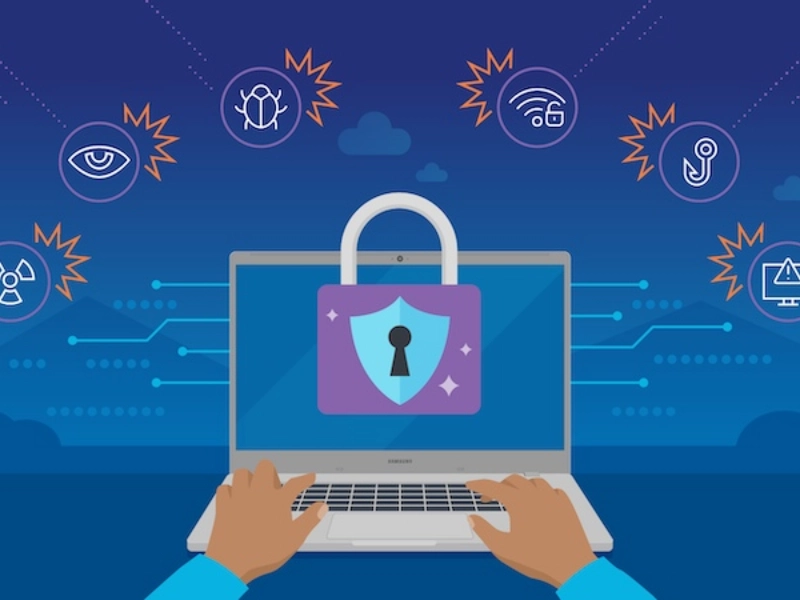Businesses are increasingly at risk from cyberattacks. These assaults take many forms, from ransomware that locks important data to phishing and malware. Terrorist groups and hostile nation-states frequently carry out these assaults with the intent to damage people, disrupt economies, and endanger national security. However, they can also be carried out by hackers who want to get rich, get even, or just satisfy their own vengeance.

 Phishing is a leading cyberthreat. Phishing is a tactic used by hackers to trick people into downloading software, steal data, and even infect their computers with ransomware.
Phishing can manifest itself in a variety of ways, such as via spam emails, man-in-the-middle exploits, smishing (SMS assaults), and vishing. Page hijacking is another tactic that attackers can employ to deceive victims into accessing a duplicate version of a website. These websites have the ability to download malware, including ransomware and other versions, or display dangerous material or phishing links.
Phishing attacks are able to evade conventional security solutions and outwit cybersecurity experts because they focus on human weaknesses rather than technological ones. Phishing risk can be decreased by training staff members to recognise phishing attacks and by fostering a cybersecurity-conscious culture. Training is only one component of the puzzle, though.
Phishing is a leading cyberthreat. Phishing is a tactic used by hackers to trick people into downloading software, steal data, and even infect their computers with ransomware.
Phishing can manifest itself in a variety of ways, such as via spam emails, man-in-the-middle exploits, smishing (SMS assaults), and vishing. Page hijacking is another tactic that attackers can employ to deceive victims into accessing a duplicate version of a website. These websites have the ability to download malware, including ransomware and other versions, or display dangerous material or phishing links.
Phishing attacks are able to evade conventional security solutions and outwit cybersecurity experts because they focus on human weaknesses rather than technological ones. Phishing risk can be decreased by training staff members to recognise phishing attacks and by fostering a cybersecurity-conscious culture. Training is only one component of the puzzle, though.
 A password is a group of characters that is used to authenticate a user's identity when they log into an account or computer. Usually, it is used in conjunction with a username to offer authentication. Hackers can guess passwords and access systems using a variety of methods.
Brute-force attacks methodically try every conceivable combination in an effort to guess security keys or login credentials. This can be done quickly and with great effectiveness, especially if the hacker is utilising automated permutation tools. Reusing passwords is extremely prevalent, and it only takes a single hacked password to reveal a sizable number of accounts.
Other techniques include man-in-the-middle attacks, in which hackers intercept data being passed between two uncompromised persons or systems and decode the information, and keyloggers, which are programmes that log every keystroke. Anything from credit card information to intellectual property can be included in this.
A password is a group of characters that is used to authenticate a user's identity when they log into an account or computer. Usually, it is used in conjunction with a username to offer authentication. Hackers can guess passwords and access systems using a variety of methods.
Brute-force attacks methodically try every conceivable combination in an effort to guess security keys or login credentials. This can be done quickly and with great effectiveness, especially if the hacker is utilising automated permutation tools. Reusing passwords is extremely prevalent, and it only takes a single hacked password to reveal a sizable number of accounts.
Other techniques include man-in-the-middle attacks, in which hackers intercept data being passed between two uncompromised persons or systems and decode the information, and keyloggers, which are programmes that log every keystroke. Anything from credit card information to intellectual property can be included in this.
 IoT devices can increase productivity and functionality for businesses, but there are also serious security dangers associated with them. Large amounts of telemetry data are frequently collected by these devices and stored in centralised databases, making them easier to target by hackers.
Man-in-the-middle (MITM) attacks and brute-force attacks are two types of IoT attacks. In an MITM attack, threat actors obstruct communication between two trusted entities, such as an IoT device and its cloud server, whereas brute force attacks include hackers trying every conceivable character combination to gain user accounts.
Hackers can create botnets and engage in ransomware, cryptocurrency mining, distributed denial-of-service attacks, and other activities using compromised Internet of Things devices. Furthermore, a lot of IoT devices are not built with security in mind, which leaves them open to hacker attacks.
IoT devices can increase productivity and functionality for businesses, but there are also serious security dangers associated with them. Large amounts of telemetry data are frequently collected by these devices and stored in centralised databases, making them easier to target by hackers.
Man-in-the-middle (MITM) attacks and brute-force attacks are two types of IoT attacks. In an MITM attack, threat actors obstruct communication between two trusted entities, such as an IoT device and its cloud server, whereas brute force attacks include hackers trying every conceivable character combination to gain user accounts.
Hackers can create botnets and engage in ransomware, cryptocurrency mining, distributed denial-of-service attacks, and other activities using compromised Internet of Things devices. Furthermore, a lot of IoT devices are not built with security in mind, which leaves them open to hacker attacks.
 Through XSS, malicious scripts can be injected into a web application that is vulnerable. When a user visits the hacked website, these scripts then start running in the browser.
XSS assaults are a useful tool for hackers to take control of systems, distribute malware, and steal data. Defacement or alteration of press releases, product manuals, and other information used to foster trust with consumers and the public can also be detrimental to a company's reputation.
By verifying and escaping all user input and routinely upgrading software with security patches and bug fixes, businesses may prevent cross-site scripting (XSS) vulnerabilities. Additionally, they might put in place a content security policy to shield consumers from malicious scripts that hackers might insert into websites. Any XSS attack that causes a data breach could result in fines or settlements from the government due to the severe obligations imposed by privacy and data protection rules like GDPR on firms to secure client information.
Through XSS, malicious scripts can be injected into a web application that is vulnerable. When a user visits the hacked website, these scripts then start running in the browser.
XSS assaults are a useful tool for hackers to take control of systems, distribute malware, and steal data. Defacement or alteration of press releases, product manuals, and other information used to foster trust with consumers and the public can also be detrimental to a company's reputation.
By verifying and escaping all user input and routinely upgrading software with security patches and bug fixes, businesses may prevent cross-site scripting (XSS) vulnerabilities. Additionally, they might put in place a content security policy to shield consumers from malicious scripts that hackers might insert into websites. Any XSS attack that causes a data breach could result in fines or settlements from the government due to the severe obligations imposed by privacy and data protection rules like GDPR on firms to secure client information.